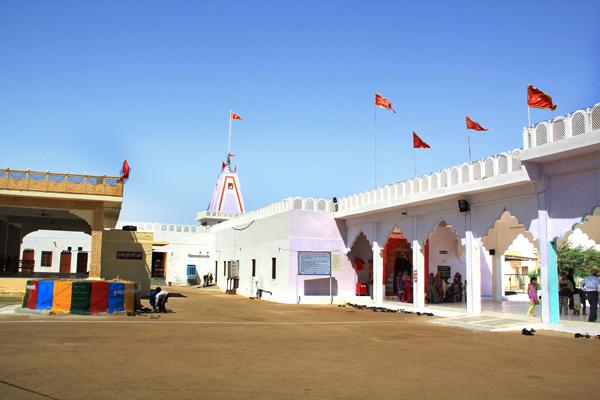Shri Tanot mata temple is situated 130 kilometres far from Jaisalmer District of Rajasthan, in the Thar Desert near the India-Pakistan border. This temple is famous for its miracles during the India-Pakistan war.
Hence, for the Indian soldiers too, this temple is a seat of deep faith. Shri Tanot mata is believed to be a form of Hinglaj mata. The Hinglaj mata temple is located in the present Baluchistan province of Pakistan.
In AD 828, the Bhati Rajput King Tanu Rao constructed the Tanot mata temple and installed the Deity’s idol. (Bhati is a community of people. Rajputs are warriors from Rajasthan)
History of inception of the temple
As per information, many years ago there was a cowherd named Mamdiya. He undertook seven pilgrimages on foot to the temple of Hinglaj mata with the hope of being blessed with progeny.
This pleased the Goddess who appeared in his dream and asked him whether he wanted a male or female child. He appealed to her, ‘O Deity, I would be happy if you took birth in my family’.
Thereafter, he was blessed with seven daughters and a son. One of them, named Awad mata, born in the Vikram Samvat 808, is the now worshipped Tanot mata Devi. No sooner was she born than she began to display her miraculous powers. The other six daughters too were Divine Energies.

All the 7 daughters of the cowherd had protected the Mad region from the Hun invasion. With the grace of Awad mata, that is Tanot mata, the Rajputs established their rule in the Mad region. The Bhati King Tanu Rao made Mad region the state’s capital city and installed Tanot mata on a gold throne.
The India-Pakistan war and miracles with reference to the temple of Tanot mata
In the India-Pakistan war of 1965, several miraculous events occurred in the temple. During the war, the role played by Tanot mata temple in defeating the Pakistani soldiers (who had infiltrated the Rajasthan territory) was very significant. The Goddess helped the Indian soldiers due to which the Pakistan army was compelled to retreat.

From 17th to 19th November 1965, the Pakistani army staged a big attack on Tanot by firing canons balls from three directions. At that time, for protection of the Tanot area a platoon consisting of 13 grenadiers and 2 platoons of Border security forces, under the leadership of Major Jaisingh, were fighting the enemy. On 16 November 1965, the enemy had infiltrated India and captured territory upto 150 kilometers. The enemy hurled 3000 bombs onto the Tanot mata temple and 450 bombs in the temple premises; but not even one exploded! Even the Pakistani soldiers stand testimony to this.
As per information given by the Pakistani soldiers, when they were hurling bombs onto the temple from a plane, instead of seeing the temple, they would see a little girl seated next to a lake. For the soldiers hiding in the temple, the Tanot mata temple proved to be protective armour. Some of the live bombs have been preserved in the temple’s museum.

After the war, the Border Security Forces took responsibility of the temple. Here, soldiers perform daily puja (ritualistic worship) of the Deity. An army base has been erected close to the temple. After the 1965 war, in 1971 soldiers from the Punjab Regiment and Border Security Forces destroyed the base of the Pakistani soldiers at Longewala.
Consequent to the Longewala victory, a victory pillar was erected in the vicinity of the temple. Every year on December 16th there is a celebration here. Also zatra (festival of a local Deity) is celebrated during Navratri in the Hindu lunar months of Ashwin and Chaitra.
PNN/Agencies






































